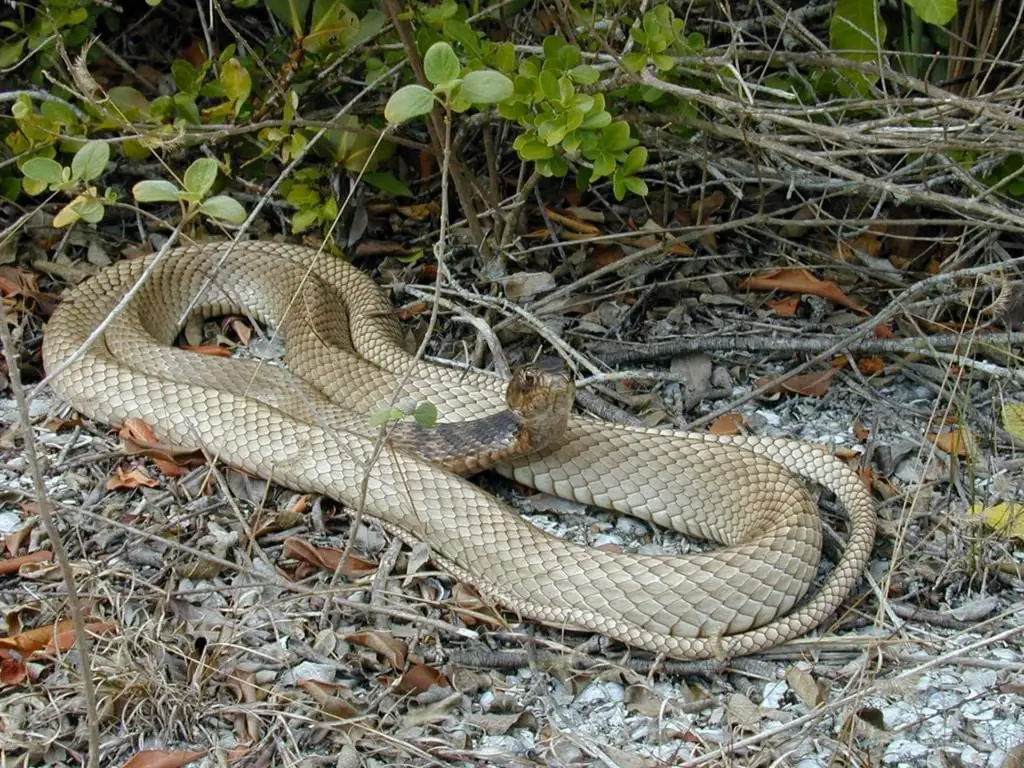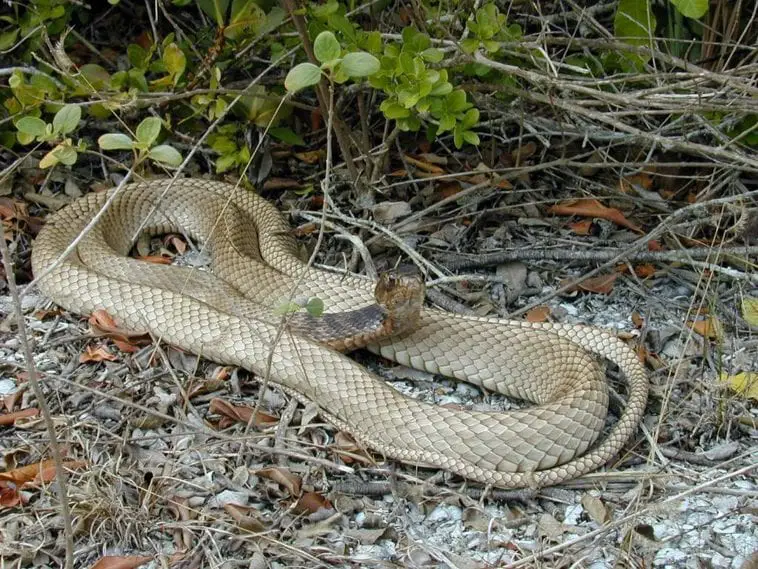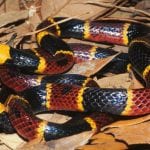Scientific Facts
| Common Name: | Eastern Coachwhip |
| Scientific Name: | Masticophis Flagellum |
| Life Span: | 12 to 20 Years |
| Length: | 91.4 to 259 centimeters |
| Clutch Size: | 11 eggs |
| Habitat: | Dry, Open Terrains |
| Country of Origin: | United States, Mexico |
Physical Description

Eastern coachwhip snakes are among the most varied species of snakes in North America. They are classified distinctly by their smooth scales. In terms of physical representation, it has been observed that there are specific variations of the species correlating with the geographic placement of the snake population.
In general, the population of this species that are located on the Eastern part of the Mississippi River is different from those that are on the Western part. Even though there are differences between and within these subspecies, their color leans toward serving as camouflage.
These snakes usually feature a dark brown anterior and dorsum part of their body, while their mid-venter is either pink or red. Coachwhip snakes are among the biggest snakes in North America, with adult snakes ranging in length from 91.4 to 259 centimeters, measured from their snout down to the vent.
Coachwhip snake subspecies also vary in physical appearance. Eastern coachwhip snakes feature a very dark anterior dorsum, which is darker in northern locations and lighter in southern geographic locations. Sonoran coachwhip snakes have black bands that are broken up by smaller red bands.
This pattern is also observed among the northern geographic range since these subspecies are described as solid-colored in the southernmost part of its range. Snakes from the Western part, on the other hand, feature a pink phase on their ventral location, with three unique color patterns.
This concept of polymorphism supports the idea that coachwhip snakes have a dark and light phase where the colors of Baja California and Red Coachwhips range from reds, yellows, and light greys to dark greys and blacks.
Juveniles, on the other hand, have a different pattern of colors with their adult counterparts. Adults can feature a number of color patterns depending on the subspecies and region, while the juvenile snakes are usually brown or solid tan with white spots that are noticeable on their snouts.
Range
The Eastern coachwhip snake is a non-venomous snake that is found in the southern part of the Nearctic Region. They are primarily limited to Mexico and the United States. In the USA, for example, their range extends as far as the west, such as the San Francisco Bay, and the east, including the Coastal Plain of North Carolina.
These snakes are also spread throughout the north, particularly in Kentucky and Kansas. They cannot be found in areas on each side of the Mississippi River. A few of these snakes have been discovered in Louisiana, as well. The geographic range of this species also extends as far as the southern region of Durango in Mexico.
Subspecies of Eastern coachwhip snakes that have been recognized are found in distinct ranges. They are found as far east as the East Coast and far west as Oklahoma. They go far north in Missouri and south as in Florida.
Home Range
Even though these snakes have home ranges with an average of 56.2 ha, their activities have been confined within the smaller parts of their range. They usually move longer distances with microhabitats, and these areas are about 8.9 ha.
Eastern coachwhip snakes do not usually travel in a direct path going to a certain location. However, with vegetation, as well as other coverage that extends their travel distance even further. During the breeding season, male snakes usually defend a certain location.
Their territory is usually a small area with potential female snakes that are located within, though the exact size of the territory has not yet been reported. This behavior of being territorial is not usually present out of the usual breeding season.
Habitat
Eastern coachwhip snakes thrive in habitats that are dry and open terrains. They are usually found in prairies, deserts, juniper-grasslands, scrublands, thorn-forests, woodlands, creek valleys, farmlands, chaparral, and swamplands. They also live in agricultural areas with vegetation.
As terrestrial species, they can maneuver around different habitats, looking for cover under rocks and in foliage. The elevation of their habitat range is 30 m (Louisiana) to 880 m (California). Since the location of their habitats varies, the elevation is similar, as well.
Related Subspecies
Among the other related and recognized subspecies of this snake includes the Sonoran coachwhip snakes (Masticophis flagellum cingulum), which can be found in all Sonoran, Mexico area, with a range extending as far north as Arizona. They are not found commonly in the Gran Desierto de Altar, which is a dune region in Sonora.
Another subspecies is the Red Coachwhip snake (Masticophis flagellum piceus), which are found in the far west of Southern California, and as far east as Arizona. There is also the Baja California coachwhip snakes (Masticophis flagellum fuliginous). They are found in the Baja, California peninsula. On the other hand, the Western Coachwhip Snakes (Masticophis flagellum testaceus), with a range that extends as far north as Nebraska, and down south in Mexico City, Mexico.
Development
Female Eastern coachwhip snakes have a gestation period of about 77.5 days. When they hatch, they usually reach up to 27.9 to 35.6 cm in length. In terms of juvenile development, there is limited study and research that supports the process.
Adult snakes can show different color patterns based on their subspecies and region, while juvenile Eastern Coachwhips are usually brown or solid tan with white spots visible on their snouts. Just like most snakes, this species go through indeterminate growth, which means that they increase in size continuously until their death. Adult snakes can grow up to 106.7 to 152.4 cm in length when measured from the snout down to the vent.
Lifespan
In the wild, the lifespan of Eastern coachwhip snakes is about 13 years. The longest recorded Eastern coachwhip snake held in captivity is 20 years. Among the most common fatality causes among these snakes are collisions with motor vehicles. There are no recorded causes of death among coachwhips that are held in captivity.
Interesting Facts
According to the U.S. Geological Survey of the Western Ecological Research Center, Eastern coachwhip snakes could offer significant insight and understanding of the process of speciation. One reason behind this is because some regional populations have become isolated due to geologic processes, including the faulting in Southern California. This results in the evolution of the distinctive characteristics of this subspecies.
Some reptile keepers think that coachwhip snakes, particularly those that are caught in the wild, are prone to biting. As such, they may be challenging to make a good pet. Others, though, like these snakes as pets even though they require special care and handling.
Some keepers think that these snakes gave rise to the myth of the presence of “hoop snake,” or snakes that usually take the tip of their tails in their mouth, creating a circle of their body, rolling along like a hope while pursuing their prey.
Behavior
Eastern coachwhip snakes are diurnal, motile, and solitary species. They are observed to be most active around mid-morning and late afternoon. According to a certain field study in Eastern Texas, these snakes were observed to be active from seven in the morning until 5 in the afternoon. They are particularly active during these times.
Unlike other snake varieties, Eastern coachwhip snakes stay active despite being exposed to the hottest time of the day, even with ambient temperatures reaching 33 degrees Celsius. The temperature of their bodies reaches 36 degrees Celsius at this time.
These snakes hibernate during winter in order to conserve energy. While hibernating, they naturally lower their internal temperature to around 17 degrees Celsius. Some snakes have also been observed to hibernate outside their territory area, ranging about 8.9 ha.
These snakes are known for their ability to climb bushes and trees in order to avoid predators. They may also go into deep burrows in order to escape their predators. These snakes are able to swim, though they are not observed to swim frequently.
Communication and Perception
Eastern coachwhip snakes communicate with and understand the outside world using their visual, motor, as well as olfactory senses. Their sense of smell is quite sensitive, allowing them to process and perceive the world surrounding them using chemical signals.
They are diurnal and active species. For this reason, they also depend highly on visual inputs in order to interpret the outside world. All Eastern coachwhip snakes come with vomeronasal organs, which enable them to capture odor substances from the air through their tongue. These particles are then perceived by these vomeronasal organs, otherwise known as the Jacobson’s organ, a group of sensory cells that allows for the interpretation of their environment.
When it comes to communicating with their predators, Eastern coachwhip snakes use their physical, visual, and auditory cues. When they feel threatened, they coil up right away, vibrating in an attempt to scare off their potential predators. If this not effective enough, they can even climb trees as well as other foliage in order to escape their predator. Thanks to their speed, they can evade a predator by fleeing right away.
Despite the visual cues being important, there is no evidence to prove that coloration is a major factor that these snakes use in selecting a mate.
Feeding and Diet
Eastern coachwhip snakes are non-venomous. Their diet mainly consists of lizards, insects, other snakes, birds, and their eggs, as well as various amphibians. Reports show certain instances wherein these snakes consume rodents and carrion, though they happen rarely.
These snakes forage a lot, actively searching for their prey. After hibernation, Eastern coachwhip snakes are primarily active at midday. As their active season comes to a close, they further increase their time in moving around, doing so in the mid-morning and late afternoons, spending these times for foraging. They usually move approximately 186 m every day. They move around from vegetation spots to burrows while looking for prey.
When it comes to foraging, Eastern coachwhip snakes depend on olfactory and visual senses in order to capture their prey. They have the capacity to perceive chemicals that are emitted out of their prey’s integumentary system, with accuracy in distinguishing species that they prey upon, particularly selecting them against those that are not their prey.
They usually flick their tongues, showing off attacking behavior when they process the chemicals from their selected prey. Lizards and other snakes are among their most common preys, eliciting the strongest response. Once they are able to locate their prey, these snakes depend on their speed in capturing the animal. Since these snakes are considered as the fastest snakes in North America, with a maximum speed of 5.8 kph, it becomes less complicated for them to capture their prey.
Predation
Eastern coachwhip snakes are identified as among the fastest snakes in North America. They have a record of 5.8 kph as their maximum speed, with the ability to turn fast. For this reason, they have few natural predators. There have also been some recorded instances where great horned owls and coyotes have preyed upon this species.
Their most effective anti-predator strategy is speed. Speed, combined with the ability to camouflage highly reduces the frequency and risk of predation among these species. When they are threatened, these snakes coil right away, striking at a predator. When distressed, they vibrate their tail.
When they are pursued by a possible predator, it is common to see these snakes entering inside rodent burrows, thus evading their pursuer. As they enter the burrows, they turn their heads immediately to protect their hinds by biting anything that attempts to pursue them. When a snake starts to bite, they are seen to thrash their head from side to side, eventually tearing their pursuant’s skin right after puncturing it.
Young coachwhip snakes, on the other hand, are likely prey to roadrunners, as well as hawks. Because of their love to bask on roadways or eating roadkills sometimes make them a victim to motor vehicle accidents. In certain areas, their habitat is declining as a result of development.
Reproduction
Male Eastern coachwhip snakes look for a breeding partner while initiating courting moves, which encourage copulation. The males usually show aggressive behaviors, one of which involves the flicking of their tongue, thus asserting dominance while ensuring copulation with their selected females.
The courting behavior happens before copulation, usually lasting for 4 to 90 minutes, while the actual copulation lasts for 15 to 130 minutes. The female snakes are described to be polyandrous, which means that they breed with several males throughout the breeding interval.
Male snakes have also been observed to protect a female they have mated with against other males, attempting to prevent succeeding copulations. In order to anticipate the highest chance of copulation, male snakes may defend their location from other male snakes during the breeding period. This behavior of being territorial is not usually observed outside the breeding season. Once the copulation, as well as the periods of gestation, have been completed, female snakes usually lay their eggs inside a nest that is located inside a burrow.
Breeding
Eastern coachwhip snakes are both iteroparous and oviparous. They usually breed once a year, from June to August. Male snakes usually reach maturity when they are one year old, though they are not likely to succeed in mating until they reach three years old. Female snakes reach their sexual maturity at three years old.
The normal gestational period among female snakes is 77.5 days on the average. They typically lay between 4 to 24 eggs, with around 11 eggs in every clutch. The eggs are white in color, oblong in size, with a granular surface, about 35 to 48 mm in length, and 17.8 to 26.3 mm in width. These snakes do not depend on their parents and can look after their own after hatching.
Female Eastern coachwhip snakes have been observed to show a significantly less active form of a lifestyle than the male snakes, especially at the peak of the breeding season. The males become more active throughout the entire day than females. This actual difference in their activities also tends to lower down as the breeding season comes to an end.
Roles in the Ecosystem
Eastern coachwhip snakes are known to play a limited role in the ecosystem. Aside from being on the predatory side, they do not depend on or provide for other animal species in ways that would encourage codependence. Parasites have been discovered to thrive inside 15% of all coachwhip snakes.
The first report on parasites which were discovered in Eastern coachwhip snakes were nematodes, in 1856. The genus Physaloptera is often considered as the most common parasites among coachwhip snakes, usually present in their stomachs. Two apicomplexan protons, Caryospora masticophis, and Eimeria zamenis, have also been discovered.
The larvae form of tapeworms from the Cestoda class, Metacestodes, is another type of parasite common among these snakes. These metacestodes are acephalic, which means that they do not have a head. This is quite notable as this type of metacestode has never been reported among non-mammal hosts before 1990. It has been found by researchers that these parasites also live in the pericardium of the snakes, thus interfering with the activity of their heart.
Other parasites among Eastern coachwhip snakes are chiggers, which comes from the family Trombiculidae. An ectoparasite is also common, a mite of the genus Liponyssus.
Importance to Humans
These snakes usually prey upon possible pest animals, including other snakes, lizards, rodents, and insects. In areas that are densely populated by humans, having a limited number of possible pests is considered as a benefit of having Eastern coachwhip snakes around.
Even though these snakes are non-venomous, they still have a painful bite. As they bite, they are also observed to whip their heads from one side to another, causing the flesh of their target to tear. When they bite a human, the bitten individual need to seek medical care in order to clean and dress the wounds appropriately. The good news, though, is that humans are not bit commonly by these snakes.
Threats and Conservation
The Eastern coachwhip snakes have been evaluated by the IUCN Red List and listed as species of “Least Concern.” CITES, the U.S Federal List, as well as the State of Michigan, have not created a special status to describe coachwhip snakes.
Among the reasons that contribute to the decline in the population of Eastern coachwhip snakes include motor vehicle collisions and habitat destruction. According to a survey that was conducted by Piedmont in South Carolina, the Eastern coachwhip snake population declined from their previous studies.
A related subspecies, however, the San Joaquin coachwhip, has been listed under “Species of Concern” by the Department of Fish and Game in California. In Illinois, on the other hand, coachwhips are listed as a “State Endangered” species by the Prairie Research Institute.
With changes in the climate, the actual cost of conservation needs to increase in order to make sure that these animals can thrive in inhabitable environments. In order to conserve the populations of Eastern coachwhip snakes that are at risk, securing their habitats should be given priority.
How to Care for Eastern Coachwhip Snakes
Due to these snakes’ unusually feisty attitude, as well as their noticeable resistance to being held, these snakes are not commonly sought by collectors and hobbyists. As such, they are not bred deliberately in captivity. Instead, hatchlings that are offered occasionally almost always come as a result of a clutch that is laid by a field-captured female and then incubated.
Coachwhips are somewhat challenging to acclimate to captivity. Most of them will bite aggressively, painfully and repeatedly. Even though they have a wide range of food options, some may stubbornly refuse to eat. Others may still eat well, loving mice as their food. These snakes frighten easily, even injuring their nose as they hit the glass of their terrarium while rubbing or striking against roughened surfaces while attempting to escape.
A single hatchling or two may be housed temporarily in a 20-gallon terrarium. A pair of adult snakes can be housed inside a 50 to 125-gallon terrarium. They are apt at abrading their nose inside a small terrarium than in a large tank.
While they love to climb, they can feel nervous about doing so, thus shying away from climbing altogether. Fir, dry cypress, bark shards, or aspen chips are among the recommended options on substrates. When it comes to the temperature inside the terrarium, a range of 78 degrees Fahrenheit at night time, and 85 degrees at daytime is recommended for Eastern coachwhip snakes. Even though they may also hesitate to bask, a hot spot can also be provided to them so that they can do so when they already feel comfortable with their environment. With this said, a hot spot with a temperature range of 90 to 95 degrees should be readily available for several hours a day. To ensure hydration, it is imperative to prepare a drinking bowl that is filled with fresh and clean water.
FAQ Section
Are Eastern Coachwhips venomous?
The Eastern Coachwhip is a non-venomous species of colubrid snakes. They are also known by the name whip snake and are endemic to the United States, as well as in the Northern half of Mexico.
Will an Eastern Coachwhip chase you?
According to folklore, coachwhip snakes are amazingly swift, pursuing and attacking a person, then squeezing its victim in its coils. Then, it lashes its prey to death using its tail.
What do Eastern Coachwhip snakes eat?
Coachwhip snakes hunt by sight, actively pursuing their prey. They usually do so with their heads held high above the ground. They also eat a wide range of prey, including amphibians, insects, snakes, lizards, rodents, and birds.
Where do Eastern Coachwhips live?
Their huge, round pupils give these snakes keen eyesight. They are spread throughout the southern part of the United States and northern Mexico. They are also commonly seen in yards and gardens across states such as Texas, California, Louisiana, New Mexico, and Florida.
Do Eastern Coachwhip snakes kill rattlesnakes?
Eastern Coachwhips are fast and visual hunters who usually prowl with their heads held high off the ground. Even though their main prey includes birds, rodents, eggs, and lizards, they are also known to kill and eat rattlesnakes when presented with the chance.
Are Eastern Coachwhip snakes aggressive?
Eastern Coachwhip snakes will be and can be very aggressive. They are fast, attempting to flee from you when threatened. However, if you try to corner these snakes or run them down, they will not hesitate to attack you. In fact, they are among the most aggressive, non-venomous snakes.
Are Eastern Coachwhip snakes the fastest in the United States?
Yes, they are. They are the fastest snakes in the United States. They have a top land speed of around 10 mph, and top airspeed at around 190 mph, similar to most aerodynamic objects that reach terminal velocity.
Can Eastern Coachwhip snakes whip you?
Folklore has it that Eastern Coachwhip snakes pursue and attack humans, squeezing them in their coils, while lashing to death. However, there have been no records that solidify this story.



